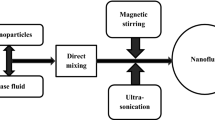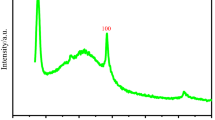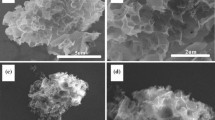Abstract
In this study, composites consisting of well-dispersed TiO2 nanoparticles deposited on the surface of reduced graphene oxide (designed as TiO2-G) were fabricated via a facile synthesis method, namely in situ hydrolysis of TiCl4 and subsequently immobilization on the surface of reduced graphene oxide. TiO2-G/water nanofluids with the nanoparticles loading of 0.02, 0.03, 0.05, 0.07, and 0.1 wt% were prepared by ultrasonic probe in the condition without the addition of surfactants. Furthermore, the stability, zeta potential, and thermal conductivity of the TiO2-G/water nanofluids were analyzed by using different experimental methods. With the nanoparticles loading of 0.02 wt% (0.015 vol%) and 0.05 wt% (0.038 vol%), the zeta potential value of TiO2-G/water nanofluids can reach up to −46.49 and −37.44 mV, respectively, exhibiting great stability. Compared to that of the base fluid, the thermal conductivity of TiO2-G/water nanofluids increased with the increase of the loading of TiO2-G composite and the temperature of the nanofluids, and reached a maximum enhancement of ~33 % at a composite concentration of 0.1 wt% (0.078 vol%). Therefore, TiO2-G/water nanofluids can be applied to heat exchanger systems, as they provide a good long-time dispersion stability and a significant thermal conductivity enhancement.











Similar content being viewed by others
References
Sadeghinezhad E, Mehrali M, Saidur R et al (2016) A comprehensive review on graphene nanofluids: recent research, development and applications. Energ Convers Manag 111:466–487
Sarkar J, Ghosh P, Adil A (2015) A review on hybrid nanofluids: recent research, development and applications. Renew Sust Energ Rev 43:164–177
Choi SUS, Eastman JA, Li S et al (2001) Anomalously increased effective thermal conductivities of ethylene glycol-based nanofluids containing copper nanoparticles. Appl Phys Lett 78:718–720
Lee GJ, Kim CK, Lee MK et al (2012) Thermal conductivity enhancement of ZnO nanofluid using a one-step physical method. Thermochim Acta 542:24–27
Li X, Chen Y, Mo S et al (2014) Effect of surface modification on the stability and thermal conductivity of water-based SiO2-coated graphene nanofluid. Thermochim Acta 595:6–10
Garg J, Poudel B, Chiesa M et al (2008) Enhanced thermal conductivity and viscosity of copper nanoparticles in ethylene glycol nanofluid. J Appl Phys 103:074301
He Y, Jin Y, Chen H, Ding Y, Cang D, Lu H (2007) Heat transfer and flow behaviour of aqueous suspensions of TiO2 nanoparticles (nanofluids) flowing upward through a vertical pipe. Int J Heat Mass Transf 50:2272–2281
Angayarkanni SA, Philip J (2015) Review on thermal properties of nanofluids: recent developments. Adv Colloid Interface Sci 225:146–176
Leong KY, Mohd HN, Mohd SR et al (2014) The effect of surfactant on stability and thermal conductivity of carbon nanotube based nanofluids. Therm Sci 78:1–12
Vlcek J, Lapcik L, Cech J, Lapcikova B (2014) Impinging jet study of the deposition of colloidal particles on synthetic polymer (Zeonor). Int J Heat Mass Transf 78:416–422
Estelle P, Halelfadl S, Mare T (2015) Thermal conductivity of CNT water based nanofluids: experimental trends and models overview. J Therm Eng 1:381–390
Goli P, Ning H, Li X, Lu CY, Novoselov KS, Balandin AA (2014) Thermal properties of graphene-copper-graphene heterogeneous films. Nano Lett 14:1497–1503
Lee GJ, Rhee CK (2013) Enhanced thermal conductivity of nanofluids containing graphene nanoplatelets prepared by ultrasound irradiation. J Mater Sci 49:1506–1511. doi:10.1007/s10853-013-7831-6
Balandin AA, Ghosh S, Bao W et al (2008) Superior thermal conductivity of single-layer graphene. Nano Lett 8:902–907
Kamatchi R, Venkatachalapathy S, Srinivas BA (2015) Synthesis, stability, transport properties, and surface wettability of reduced graphene oxide/water nanofluids. Int J Therm Sci 97:17–25
Ramaprabhu S, Baby TT (2011) Enhanced convective heat transfer using graphene dispersed nanofluids. Nanoscale Res Lett 6:289
Ghozatloo A, Rashidi AM (2013) Preparation of nanofluids from functionalized graphene by new alkaline method and study on the thermal conductivity and stability. Int Commun Heat Mass 42:89–94
Zhang YY, Pei QX, He XQ, Mai YW (2015) A molecular dynamics simulation study on thermal conductivity of functionalized bilayer graphene sheet. Chem Phys Lett 622:104–108
Ijam A, Golsheikh AM, Saidur R, Ganesan P (2014) A glycerol–water-based nanofluid containing graphene oxide nanosheets. J Mater Sci 49:5934–5944. doi:10.1007/s10853-014-8312-2
Ye J, Zhang H, Chen Y, Cheng Z, Hu L, Ran Q (2012) Supercapacitors based on low-temperature partially exfoliated and reduced graphite oxide. J Power Sources 212:105–110
Huang Z, Zhang H, Chen Y, Wang W, Chen Y, Zhong Y (2013) Microwave-assisted synthesis of functionalized graphene on Ni foam as electrodes for supercapacitor application. Electrochim Acta 108:421–428
Park AR, Zhang K, Park JH, Yoo PJ et al (2012) Green synthesis of biphasic TiO2-reduced graphene oxide nanocomposites with highly enhanced photocatalytic activity. ACS Appl Mater Interf 4:3893–3901
Sen S, Govindarajan V, Pelliccione CJ, Dean J et al (2015) Surface modification approach to TiO2 nanofluids with high particle concentration, low viscosity, and electrochemical activity. ACS Appl Mater Interf 7:20538–20547
Xu YJ, Zhuang Y, Fu X (2010) New insight for enhanced photocatalytic activity of TiO2 by doping carbon nanotubes: a case study on degradation of benzene and methyl orange. J Phys Chem C 114:2669–2676
Shao Y, Wang LJ et al (2015) Graphene-based materials for flexible supercapacitors. Chem Soc Rev 44:3639–3665
Fan Y, Lu HT, Liu JH et al (2011) Hydrothermal preparation and electrochemical sensing properties of TiO2-graphene nanocomposite. Colloid Surface B 83:78–82
Deng P, Zhang H, Chen Y et al (2015) Facile fabrication of graphene/nickel oxide composite with superior supercapacitance performance by using alcohols-reduced graphene as substrate. J Alloys Compd 644:165–171
Akhavan O, Abdolahad M, Esfandiar A (2010) Photodegradation of graphene oxide sheets by TiO2 nanoparticles after a photocatalytic reduction. J Phys Chem C 114:12955–12959
Cao M, Wang P, Ao Y, Wang C, Hou J, Qian J (2015) Photocatalytic degradation of tetrabromobisphenol A by a magnetically separable graphene–TiO2 composite photocatalyst: mechanism and intermediates analysis. Chem Eng J 264:113–124
Rao Y (2010) Nanofluids: stability, phase diagram, rheology and applications. Particuology 8:549–555
Baby TT, Ramaprabhu S (2011) Synthesis and nanofluid application of silver nanoparticles decorated graphene. J Mater Chem 21:9702
Baby TT, Sundara R (2011) Synthesis and transport properties of metal oxide decorated graphene dispersed nanofluids. J Phys Chem C 115:8527–8533
Baby TT, Ramaprabhu S (2010) Investigation of thermal and electrical conductivity of graphene based nanofluids. J Appl Phys 108:124308
Xie H, Fujii M, Zhang X (2005) Effect of interfacial nanolayer on the effective thermal conductivity of nanoparticle-fluid mixture. Int J Heat Mass Transf 48:2926–2932
Mehrali M, Sadeghinezhad E, Latibari ST et al (2014) Investigation of thermal conductivity and rheological properties of nanofluids containing graphene nanoplatelets. Nanoscale Res Lett 9:1–12
Dhar P, Gupta SS, Chakraborty S et al (2013) The role of percolation and sheet dynamics during heat conduction in poly-dispersed graphene nanofluids. Appl Phys Lett 102:163114
Gupta SS, Siva VM, Krishnan S et al (2011) Thermal conductivity enhancement of nanofluids containing graphene nanosheets. J Appl Phys 110:084302
Sarsam WS, Amiri A, Yarmand H, Kazi SN, Badarudin A (2016) Stability and thermophysical properties of water-based nanofluids containing triethanolamine-treated graphene nanoplatelets with different specific surface areas. Colloids Surface A 500:17–31
Hajjar Z, Ghozatloo A et al (2014) Enhanced thermal conductivities of graphene oxide nanofluids. Int Commun Heat Mass 57:128–131
Yu W, Xie H, Chen W (2010) Experimental investigation on thermal conductivity of nanofluids containing graphene oxide nanosheets. J Appl Phys 107:094317
Amiri A, Sadri R et al (2015) Performance dependence of thermosyphon on the functionalization approaches: an experimental study on thermo-physical properties of graphene nanoplatelet-based water nanofluids. Energ Convers Manag 92:322–330
Acknowledgements
This work was supported by the link project of the National Natural Science Foundation of China and Guangdong Province (No. U1401246), the National Natural Science Foundation of China (Grant Nos. 51276044, 51502043), the Guangdong Natural Science Foundation for Distinguished Young Scholar (Grant No. 2016A030306030), the Natural Science Foundation of Guangdong Province of China (2014A030310382), the Science and Technology Program of Guangdong Province of China (Grant Nos. 2014B010106005, 2015B010135011, 2015A050502047, 2016A020221031), the Science and Technology Program of Guangzhou City of China (Grant No. 201508030018), and the Special Program for Public Interest Research and Capability Construction of Guangdong (Grant No. 2014A010105047).
Author information
Authors and Affiliations
Corresponding authors
Rights and permissions
About this article
Cite this article
Wang, S., Li, Y., Zhang, H. et al. Enhancement of thermal conductivity in water-based nanofluids employing TiO2/reduced graphene oxide composites. J Mater Sci 51, 10104–10115 (2016). https://doi.org/10.1007/s10853-016-0239-3
Received:
Accepted:
Published:
Issue Date:
DOI: https://doi.org/10.1007/s10853-016-0239-3




